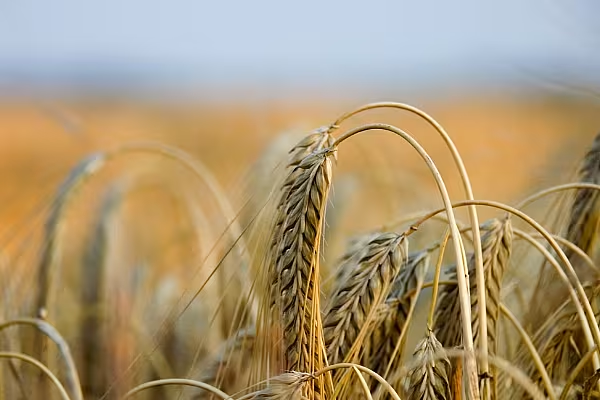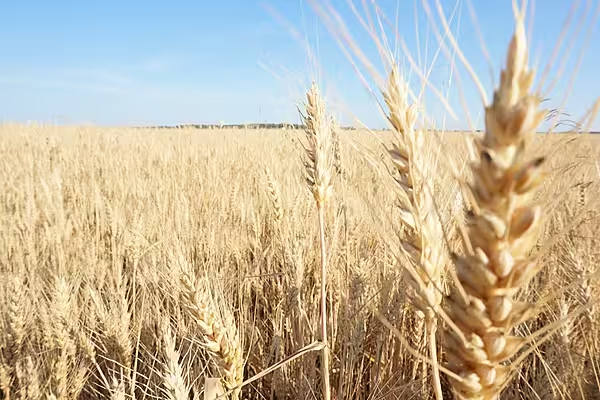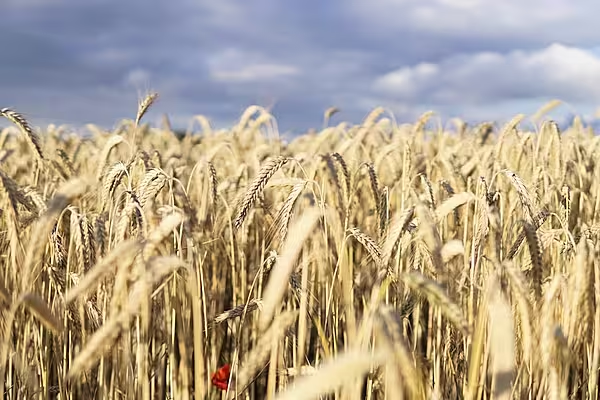A global glut of wheat isn’t producing many bargains for U.S. flour millers who need high-protein grain used in bagels, pizza crust and specialty breads. Tightening supplies mean buyers are paying premiums that have tripled in six months.
American farmers produce two main types of wheat, and stockpiles of the winter variety surged over the past two months with the best harvest yields of all time from top grower Kansas. But getting more kernels and starch per plant used up nutrients and left less-than-normal amounts of protein -- the compound that determines how sticky and stretchy dough becomes.
That’s boosting the appeal of the smaller spring-wheat crop that growers are preparing to collect in northern parts of the Great Plains, including top producer North Dakota. Because the grain normally has a higher protein content, its premium over winter wheat has ballooned even as record global output of all varieties are set to exceed demand for a fourth straight year and benchmark prices in Chicago are the lowest since 2006.
“Protein is in scarce supply,” said Tanner Ehmke, a senior economist at CoBank in Greenwood Village, Colorado. “You’re seeing this all over the world. Russia is harvesting record yields, Europe is harvesting record yields, and their protein is lower.”
At the start of this year, hard red spring wheat futures traded in Minneapolis were about 25 cents a bushel more expensive than hard red winter wheat futures in Chicago. The gap between the two varieties jumped as high as 91.75 cents this month, and was at 78.25 cents on Wednesday. Over the past decade, the average spread was about 38 cents, exchange data show.
Global Surplus
The premium widened even as signs of an expanding global surplus eroded all prices. Hard red winter wheat futures on the Chicago Board of Trade have tumbled 12 percent this year to $4.12 a bushel, while spring wheat on the Minneapolis Grain Exchange slid just 1 percent to $4.885 a bushel. The benchmark wheat futures in Chicago touched $4.065 yesterday, the lowest for a most-active contract since 2006.
The U.S. was the world’s largest wheat exporter for more than five decades but has been overtaken by Russia, where production has surged. Canada, expected to be the third-largest shipper, probably will harvest 16 percent more spring wheat this year than in 2015, according to commodity trader Gap SA Grains & Produits. But a bigger Canadian crop probably will mean reduced quality, said Ken Ball, a senior adviser at PI Financial in Winnipeg, Manitoba.
Higher bids for spring spring wheat reflect the lack of high-quality varieties. On average, the protein content of the hard red winter wheat collected this year may be the lowest in at least two decades, at 11.2 percent, compared with 12.3 percent in 2015, U.S. Wheat Associates, an export group, said in a report last week. The decline, based on preliminary samples, reflects “exceptional” yields that were higher than producers anticipated when applying fertilizer, according to the report.
More Gluten
Higher protein levels are associated with greater gluten, the element that gives dough its strength, according to Frayne Olson, crop economist at North Dakota State University in Fargo. Wheat can be blended across varieties to meet a baker’s desired characteristics, which may put spring wheat in demand this season, he said.
Unlike winter wheat, domestic production of spring wheat is expected to drop. The U.S. Department of Agriculture estimates a crop of 550.5 million bushels this season, as lower acreage offsets improved yields. The Wheat Quality Council begins its annual review of the crop next week, with about 70 millers, grain traders, bakers and farmers sampling fields across North Dakota and in surrounding states. The quality of the grain won’t be known until it’s collected, according to executive vice president Ben Handcock.
A smaller crop means spring-wheat inventories by June 1, 2017, probably will drop from a year earlier for the first time since 2012, the USDA estimates.
Paying More
Near Onida, South Dakota, collection of the spring crop has begun, and quality of the 116,000 bushels brought in to Oahe Grain Corp. elevators so far is “excellent,” with protein slightly above average at 14.7 percent, said Tim Luken, the general manager. Oahe, which purchases spring wheat and hard red winter wheat, paid a 77-cent premium this week for the spring variety, compared to 43 cents a year earlier, Luken said.
“Once we figure out what we’re dealing with, the international market may realize we’re also going to have to start shopping around for some higher proteins or higher-quality wheats to be able to blend in to get the quality we need for our bread products,” North Dakota State’s Olson said.
News by Bloomberg, edited by ESM. To subscribe to ESM: The European Supermarket Magazine, click here.














